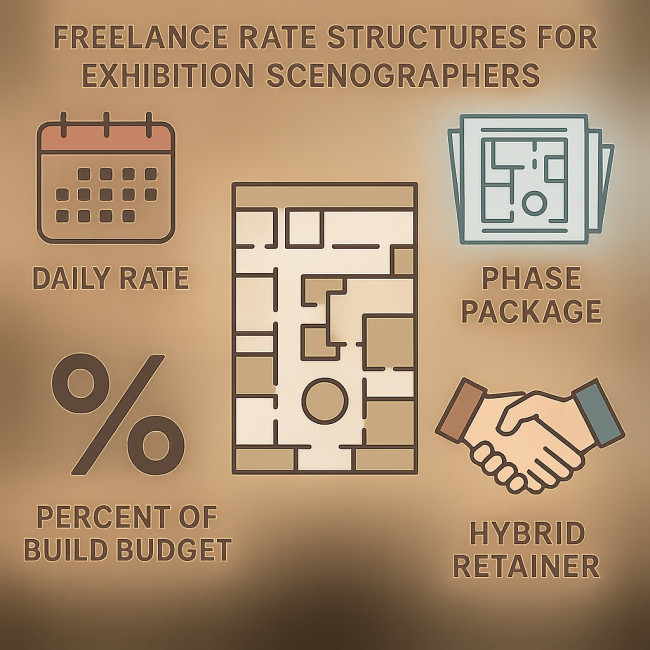Exhibition scenographer freelance rates: negotiate fair fees with museums
Wondering how much to charge for your next museum exhibition? This guide breaks down common rate structures, hidden cost drivers, and proven negotiation tactics so you can price confidently and land sustainable projects.
Understand the museum's budget logic before you quote
Museums juggle public funding, private donations, and ticket sales. Their cash flow often follows fiscal years and grant cycles. When you discover where the money actually comes from, you can time your pitch when budgets are being allocated instead of already spent.
- Permanent galleries enjoy multi-year capital budgets but demand higher durability standards.
- Temporary exhibitions rely on seasonal sponsorships; curators often have discretionary room for design innovation.
- Touring shows operate on complex cost-sharing models. Factor in extra contingencies for shipping and re-mounting.
Freelance rate structures commonly used in scenography

To help decision makers instantly grasp how each pricing approach maps to their internal approval workflow, imagine an infographic that juxtaposes the four models side by side. A small calendar icon anchors the daily rate column, signaling straightforward time billing. Beside it, a stack of draft blueprints embodies the phase package method, reminding curators that sign-offs happen in stages. A bold percentage symbol overlays a construction budget sheet to illustrate the scalable model that moves in lockstep with spend. Finally, a handshake hovering above overlapping invoices conveys the hybrid retainer's balance of predictability and flexibility. When presented together on a single visual grid, these cues make it easier for non-design stakeholders to pick the structure that matches their cash-flow realities without drowning in jargon.
| Model | What it covers | Pros | Cons |
|---|---|---|---|
| Daily rate | On-site design, supervision, meetings | Easy to benchmark | Scope creep risk if tasks expand |
| Phase package | Concept, design development, production drawings | Aligns with museum milestones | Requires clear deliverables per phase |
| Percent of build budget | Typically 8–15 % of scenographic spend | Scales with project size | Less attractive to low-budget institutions |
| Hybrid retainer | Monthly base + billable extras | Smooth cash flow for long builds | Admin to track add-ons |
Variables that shift your fee by 20 % or more
1. Complexity and storytelling depth
Interactive media, multi-sensory zones and conservation constraints all raise design hours. Point curators to case studies like data-driven visitor-flow layouts to justify additional time.
2. Material strategy
Source-efficient finishes can lower build costs while keeping your design fee intact. Share a materials plan inspired by the eco-smart exhibition materials roadmap to win budget owner confidence.
3. Digital pre-visualisation scope
Virtual walk-throughs can slash prototype iterations but add upfront hours. If you offer VR pre-visualisation pipelines, price them as optional modules to avoid sticker shock.
4. Insurance and liability
Touring artifacts or fragile installations? Costs rise fast. Link your quote to industry standards outlined in the scenographic insurance checklist.
A step-by-step negotiation framework
- Discovery call – Map project phases, stakeholders, and decision deadlines. Ask for the exhibition floor plan, object list, and any pre-approved vendors.
- Value framing – Position your impact on attendance, accessibility, and sponsorship attraction. Reference successful case studies to anchor value.
- Present tiered options – Offer three packages: Essential, Enhanced, and Flagship. Each includes a precise number of revisions and site visits.
- Negotiate on scope, not on worth – If budgets are tight, remove deliverables such as custom furniture prototypes rather than lowering your day rate.
- Document in writing – Use bullet-proof briefs similar to those described in crystal-clear exhibition briefs.
Prevent scope creep with airtight deliverables
Include a definition of “minor change” versus “new concept.” Attach a schedule of rates for out-of-scope requests. Museums appreciate predictability, and you protect your margin.
Contract clauses you should never skip
- Milestone payment schedule linked to sign-offs, not calendar dates.
- Intellectual property – grant usage to the museum, retain authorship. See how to maintain visibility through co-authoring agreements.
- Force majeure & pandemic delays – spell out restart fees.
- Attribution requirements – ensure your name appears on the wall label and the online roster of spatial design collaborators.
When and how to revise your rates
Review fees every two exhibitions or annually—whichever comes first. Track metrics: hours spent, margin per phase, and client satisfaction scores. If you've improved throughput by adopting parametric templates, capture that value in your next quote instead of gifting it away.
FAQ
- What is a realistic daily rate for a freelance exhibition scenographer in 2024?
- In Europe, experienced specialists charge €450 – €750 per day. Rates in North America range from $600 – $1,000, depending on museum size and complexity.
- Should I agree to a percentage-based fee?
- Yes, when the build budget exceeds €150,000. It scales your compensation with project ambition but still requires a minimum retainer to secure your calendar.
- How many revisions are reasonable to include?
- Two major design revisions per phase is standard. Additional tweaks should trigger your out-of-scope rate card.
Quick self-test: Are you ready to negotiate?
Next step: secure profitable collaborations
If you want more museum leads that respect your pricing, refine your portfolio narrative using the tips in mood-board-driven portfolios. Ready to quote your next show? Build your tiered rate card today and approach curators with confidence.
Call to action: Download our free rate-card template and start negotiating like a pro.











